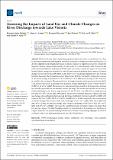| dc.description.abstract | The Lake Victoria basin’s expanding population is heavily reliant on rainfall and river flow
to meet their water needs, making them extremely vulnerable to changes in climate and land use. To
develop adaptation and mitigation strategies to climate changes it is urgently necessary to evaluate the
impacts of climate change on the quantity of water in the rivers that drain into Lake Victoria. In this
study, the semi-distributed hydrological SWAT model was used to evaluate the impact of current land
use and climate changes for the period of 1990–2019 and assess the probable future impacts of climate
changes in the near future (2030–2060) on the Simiyu river discharge draining into Lake Victoria,
Northern Tanzania. The General Circulation Model under RCPs 4.5, 6.0 and 8.5 predicted an increase
in the annual average temperature of 1.4 ◦C in 2030 to 2 ◦C in 2060 and an average of 7.8% reduction
in rainfall in the catchment. The simulated river discharge from the hydrological model under RCPs
4.5, 6.0 and 8.5 revealed a decreasing trend in annual average discharge by 1.6 m3/s from 5.66 m3/s
in 2019 to 4.0 m3/s in 2060. The increase in evapotranspiration caused by the temperature increase
is primarily responsible for the decrease in river discharge. The model also forecasts an increase in
extreme discharge events, from a range between 32.1 and 232.8 m3/s in 1990–2019 to a range between
10.9 and 451.3 m3/s in the 2030–2060 period. The present combined impacts of climate and land
use changes showed higher effects on peak discharge at different return periods (Q5 to Q100) with
values of 213.7 m3/s (Q5), 310.2 m3/s (Q25) and 400.4 m3/s (Q100) compared to the contributions
of climate-change-only scenario with peak discharges of 212.1 m3/s (Q5), 300.2 m3/s (Q25) and
390.2 m3/s (Q100), and land use change only with peak discharges of 295.5 m3/s (Q5), 207.1 m3/s
Q25) and 367.3 m3/s (Q100). However, the contribution ratio of climate change was larger than
for land use change. The SWAT model proved to be a useful tool for forecasting river discharge in
complex semi-arid catchments draining towards Lake Victoria. These findings highlight the need for
catchment-wide water management plans in the Lake Victoria Basin. | en_US |

